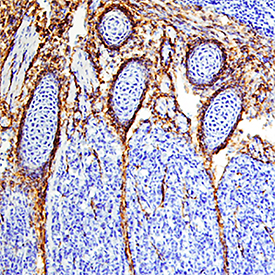Mouse EGFR Biotinylated Antibody Summary
Applications
Please Note: Optimal dilutions should be determined by each laboratory for each application. General Protocols are available in the Technical Information section on our website.
Scientific Data
 View Larger
View Larger
EGFR in Mouse Embryo. EGFR was detected in immersion fixed frozen sections of mouse embryo (13 d.p.c.) using Goat Anti-Mouse EGFR Biotinylated Antigen Affinity-purified Polyclonal Antibody (Catalog # BAF1280) at 15 µg/mL overnight at 4 °C. Tissue was stained using the Anti-Goat HRP-DAB Cell & Tissue Staining Kit (brown; Catalog # CTS008) and counterstained with hematoxylin (blue). Specific staining was localized to developing muscle. View our protocol for Chromogenic IHC Staining of Frozen Tissue Sections.
Reconstitution Calculator
Preparation and Storage
- 12 months from date of receipt, -20 to -70 degreesC as supplied. 1 month, 2 to 8 degreesC under sterile conditions after reconstitution. 6 months, -20 to -70 degreesC under sterile conditions after reconstitution.
Background: EGFR
The EGFR subfamily of receptor tyrosine kinases comprises four members: EGFR (also known as Her1, ErbB1, or ErbB), ErbB2 (Neu, Her2), ErbB3 (Her3), and ErbB4 (Her4). All family members are type I transmembrane glycoproteins. They contain an extracellular ligand binding domain containing two cysteine-rich domains and a cytoplasmic domain containing a membrane-proximal tyrosine kinase domain followed by multiple tyrosine autophosphorylation sites (1, 2). The mouse EGFR cDNA encodes a 1210 amino acid (aa) precursor with a 24 aa signal peptide, a 623 aa extracellular domain (ECD), a 23 aa transmembrane segment, and a 540 aa cytoplasmic domain (3). Soluble receptors consisting of the extracellular ligand binding domain are generated by alternate splicing in human and mouse (4-6). Within the ECD, mouse EGFR shares 88% and 93% aa sequence identity with human and rat EGFR, respectively. It shares 44-48% aa sequence identity with the ECD of mouse ErbB2, ErbB3, and ErbB4. EGFR binds a subset of the EGF family ligands, including EGF, amphiregulin, TGF-alpha, betacellulin, epiregulin, HB-EGF, and epigen (1, 2). Ligand binding induces EGFR homodimerization as well as heterodimerization with ErbB2, resulting in kinase activation, heterodimerization tyrosine phosphorylation and cell signaling (7-11). EGFR can also be recruited to form heterodimers with the ligand-activated ErbB3 or ErbB4. EGFR signaling regulates multiple biological functions including cell proliferation, differentiation, motility, and apoptosis (12, 13). EGFR is over-expressed in a wide variety of tumors and is the target of several anti-cancer drugs (14).
- Singh, A.B. and R.C. Harris (2005) Cell. Signal. 17:1183.
- Shilo, B.Z. (2005) Development 132:4017.
- Avivi, A. et al. (1991) Oncogene 6:673.
- Reiter, J.L. and N.J. Maihle (1996) Nucleic Acids Res. 24:4050.
- Reiter J.L. et al. (2001) Genomics 71:1.
- Xu, Y.H. et al. (1984) Nature 309:806.
- Graus-Porta, D. et al. (1997) EMBO J. 16:1647.
- Yarden, Y. et al. (1987) Biochemistry 26:1434.
- Burgess, A.W. et al. (2003) Mol. Cell 12:541.
- Lemmon, M.A. et al. (1997) EMBO J. 16:281.
- Cohen, S. et al. (1982) J. Biol. Chem. 257:1523.
- Sibilia, M. and E.F. Wagner (1995) Science 269:234.
- Miettinen, P.J. et al. (1995) Nature 376:337.
- Roskoski Jr., R. (2004) Biochem. Biophys. Res. Commun. 319:1.
Product Datasheets
Citations for Mouse EGFR Biotinylated Antibody
R&D Systems personnel manually curate a database that contains references using R&D Systems products. The data collected includes not only links to publications in PubMed, but also provides information about sample types, species, and experimental conditions.
2
Citations: Showing 1 - 2
Filter your results:
Filter by:
-
A fluorescent perilipin 2 knock-in mouse model reveals a high abundance of lipid droplets in the developing and adult brain
Authors: Madsen, S;Delgado, AC;Cadilhac, C;Maillard, V;Battiston, F;Igelbüscher, CM;De Neck, S;Magrinelli, E;Jabaudon, D;Telley, L;Doetsch, F;Knobloch, M;
Nature communications
Species: Transgenic Mouse
Sample Types: Whole Cells, Whole Tissue
Applications: Immunocytochemistry, Immunohistochemistry -
In situ neutrophil efferocytosis shapes T cell immunity to influenza infection
Authors: K Lim, TH Kim, A Trzeciak, AM Amitrano, EC Reilly, H Prizant, DJ Fowell, DJ Topham, M Kim
Nat. Immunol., 2020-08-03;0(0):.
Species: Mouse
Sample Types: Whole Cells
Applications: Flow Cytometry
FAQs
No product specific FAQs exist for this product, however you may
View all Antibody FAQsReviews for Mouse EGFR Biotinylated Antibody
Average Rating: 4 (Based on 1 Review)
Have you used Mouse EGFR Biotinylated Antibody?
Submit a review and receive an Amazon gift card.
$25/€18/£15/$25CAN/¥75 Yuan/¥2500 Yen for a review with an image
$10/€7/£6/$10 CAD/¥70 Yuan/¥1110 Yen for a review without an image
Filter by:






